About Us
St. George's Cathedral, established in 1816, stands as a remarkable symbol of God's love for His people and a testament to Chennai city's rich history. Designed by Colonel J.L. Caldwell, the senior engineer at the Presidency, with assistance from Captain De Havilland, the Cathedral is located in the heart of the city. In addition to its architectural brilliance, St. George’s Cathedral played a significant role in church history—the inauguration of the Church of South India occurred here on September 27, 1947. As the mother church for the whole of CSI and the Diocese of Madras, it continues to be a beacon of hope and joy.
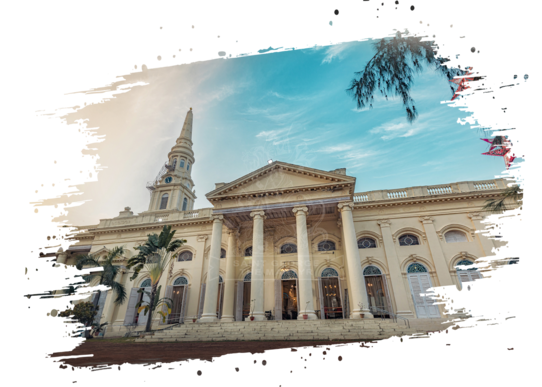
History
The Cathedral’s fascinating history narrates the unwavering journey of believers who joined forces to construct God’s house, fuelled by faith and perseverance.
It all began sometime after 1763 when the European officials and merchants began to build houses outside the Fort and there was a need for the church in the neighbourhood where the people lived. A request was raised by Rev Richard Hall Kerr as early as 1807 or perhaps earlier to the Governor to build a church on the Choultry Plain. The money was raised through a lottery fund, contributed both by the Europeans and the locals some of whom were non-Christians. To ensure that the non-Christians also benefitted from the fund, a portion of it was allotted to the upkeep of the roads.
The church was designed by Colonel J.L. Caldwell, the company’s senior engineer at the Presidency and Captain De Havilland, his junior carried out the design. The Cathedral was one of the six Churches to be built in India (before 1833) without Government assistance. The Church of England established the Anglican Dioceses of India, Burma and Ceylon in the year 1813 and appointed the first Bishop at Calcutta. When the church was completed in 1815, the Bishop of Calcutta, Rt. Rev. Thomas Fanshaw Middleton consecrated the building to the service of God according to the use of the Church of England on January 8, 1816. St. George’s Church, Choultry Plain, became the Cathedral of the Diocese of Madras in 1835 when Bishop Daniel Corrie was consecrated as the first Bishop of Madras.
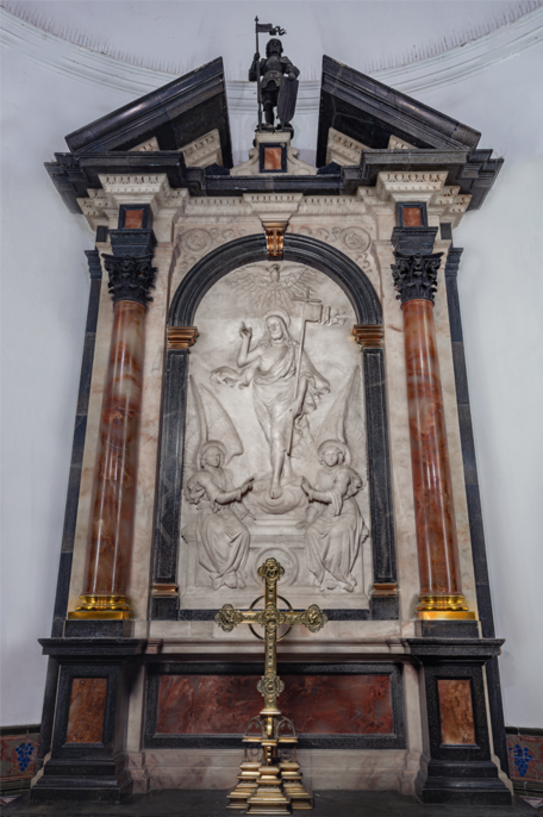
Interesting Facts about the Cathedral
Sources: Cotton, Julian James, ICS. List of Inscriptions on Tombs & Monuments in MadrasVol I, 1945, and Frank, Rev. Penny. The Church in Madras, Vol II, 1912.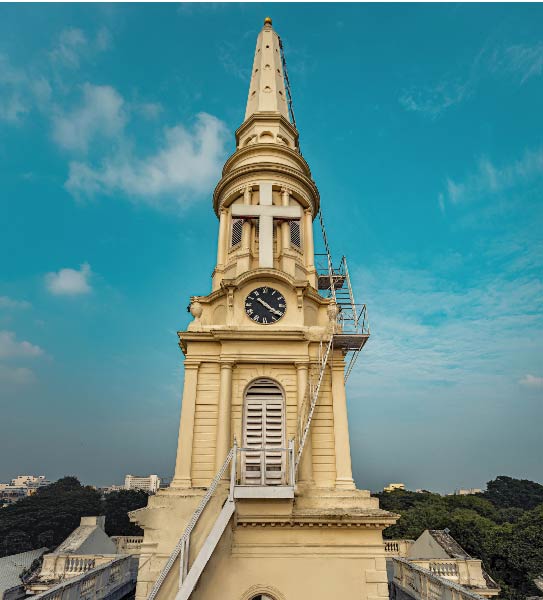
While the architecture is similar to the St Martin-in-the-Fields, London, the spire is 139 feet high and is almost identical in design to that of St. Giles’ in the Fields, London.
The turret clock was a present from the Court of Directors to the trustees of St. George’s Cathedral in the year 1828.
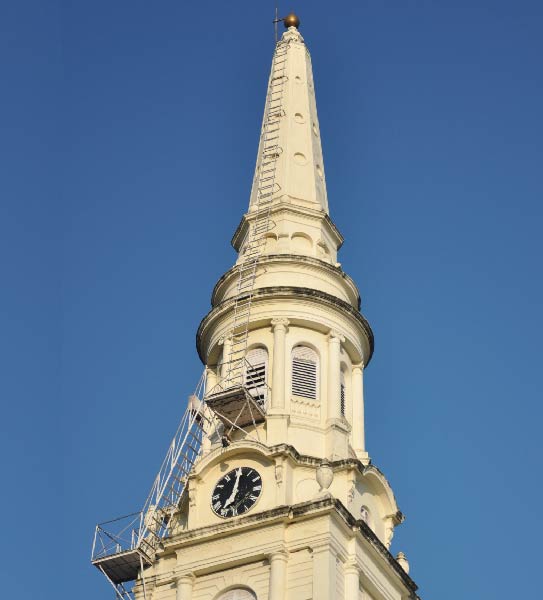
The organ was obtained from Hills & Sons, London in 1857. An eminent organist, Dr. Garret was appointed as the organist who later became a Professor of Music at Cambridge.
Originally, a gallery was built at the west end for the choir, and the organ was placed in a chamber under the spire. In 1887, Mr. Mayne brought the organ from the west to the east end.
In 1871, the congregation gifted a peal of six bells. When Rev. Thomas Foulkes, A Chaplain, heard that the bells put a great strain on the stability of the spire, he presented the Trustees with a chiming apparatus.
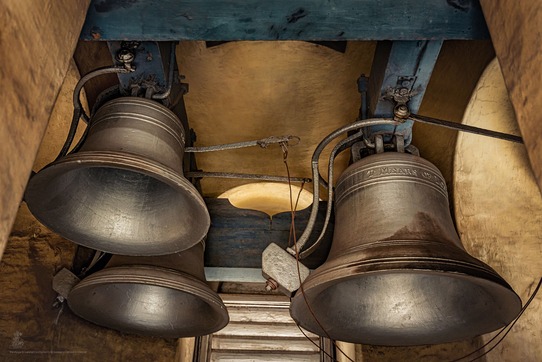
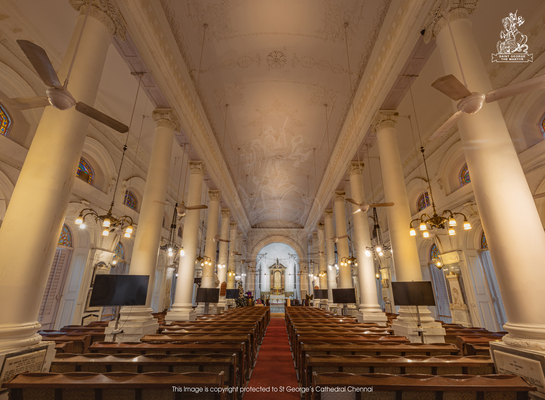
In 1884, the false roof showed signs of decay, and it was decided to renew it with teak wood. The wood was decorated with a pattern in papier-mâché and the whole roof was painted white.
The Litany stool, the bishop’s throne, and the different clergy stalls were made according to the taste and skill of Mr. W.S. Whiteside of the Civil Service, whose hobby was wood carving.
.png)
.jpg)
St. George’s Cathedral serves not only as a place of worship but also as a historical repository, captured in marble and metal. The numerous marble statues and mural tablets inside the cathedral chronicle the contributions of bishops, archbishops, scholars, statesmen, missionaries, and military leaders – individuals who significantly impacted the lives of people in India.
St. George’s Cathedral boasts a lush green landscape, a serene oasis amidst the bustling cityscape. This verdant sanctuary offers a tranquil retreat for contemplation and reflection. The harmonious blend of nature’s artistry with the Cathedral’s majestic architecture creates an atmosphere of divine grace, making the garden not just a visual delight but a spiritual haven as well.
.jpg)
.jpg)
The Gateway to the cemetery was constructed in 1882. The unique feature of the Gateway is that it houses a bell of diameter 3’7” and height 4’5”. The tone of the bell is so deep in its resonance that in the old days, whenever it was tolled at a funeral, everyone in Madras, could hear it.
The Cathedral has a large cemetery located in its south-eastern quadrant. The first interment was Elizabeth de Havilland (1818), spouse of Major de Havilland who oversaw the Cathedral’s construction. The cemetery serves as a hallowed ground for many esteemed individuals who have dedicated their lives to the service of both the church and the nation.
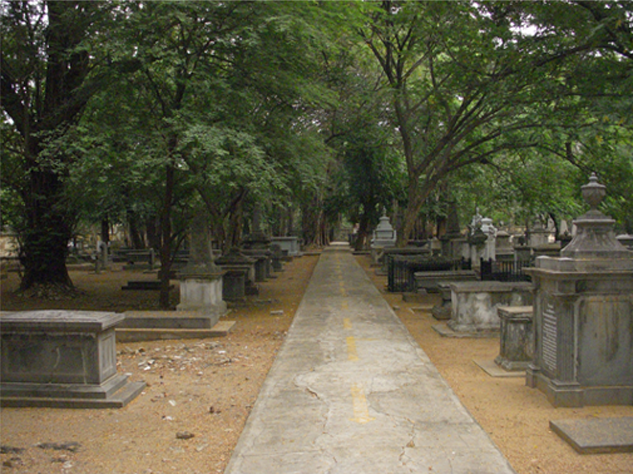
Here are some links on more interesting facts about the Cathedral
SGC Trust and Pastorate Committee
The St. George’s Cathedral Trust, a charitable organization, diligently maintains the beautiful cathedral campus. Their care extends to the Cathedral cemetery—a final resting place for church members. Additionally, the Trust operates ‘Nimmadhi Illam,’ a Senior Citizen’s Home in Royapettah. This peaceful haven provides rest and comfort for elderly individuals. The Trust also supports church members in need and extends assistance to other village churches when required.
The St. George’s Cathedral Trustees are
| Rev. S. Augustin Premraj (Chairman & Clergy Trustee) |
| Mrs. Leonora James (Secretary) |
| Mr. John Mathew (Treasurer) |
| Mr. P. Koilpitchai (Trustee) |
| Mrs. Stella Alfred (Trustee) |
The Pastorate Committee consists of thirteen members elected by the congregation, following the electoral process outlined in the Constitution of The Church of South India. These members serve in an honorary capacity and are primarily responsible for handling administrative tasks related to the Church.
| Rev. S. Augustin Premraj, Chairman |
| Rev. T. Devaputhiran, Senior Presbyter |
| Rev. Dhavaseeli, Assistant Presbyter |
| Mr. Arun David Ambrose - Hon. Secretary |
| Dr. Mrs. Mercy Rajasekar - Hon. Treasurer |
| Mr. Andrew Apollo - Hon. Asst. Secretary |
| Dr. Ms. Amritha Samson |
| Mr. Joseph Reginald Isaac |
| Mr. Sam Samuel |
| Mr. J.J.R. Edwin |
| Mrs. Christina Aristotle |
| Mr. John Christopher |
| Dr. Mrs. Mary Thomas |
The Lay Eucharistic Ministers are lay people licensed by the bishop to assist the Presbyter-in-chargein administering the elements of Holy Communion, the consecrated bread and wine.
| Mr. Dhanraj Stephens |
| Dr. Mrs. Mary Thomas |
| Mrs. Percis Christopher |
| Mrs. SarithaSunderraj |
| Mr. Paul Jayakar |
| Dr. Mrs. Rennet Samson |
| Mr. Shelly Aristotle |
Cathedral Sexton
| Mr. Samuel Aaron |
